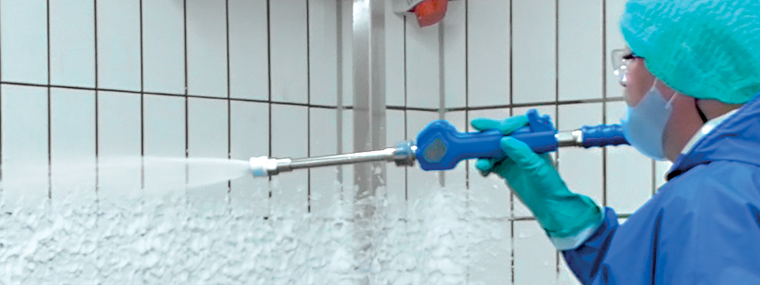
Ensuring Hygiene in Production Facilities in the Food Industry
By R+M/Suttner / Published February 2020

As consumers expect hygienic food, and manufacturers in the food industry attach great importance to the quality of their products, it is imperative to avoid microbial contamination and the formation of biofilms. This makes targeted cleaning of the means of production indispensable. The nuts and bolts are the appropriate cleaning tools and their proper application. First, it must be recognized where the germ cells for bacteria and pathogens are located in the production process in order to initiate effective control, not only to ensure compliance with the legal limits but also to minimize the number of undesirable microorganisms in terms of product quality.
 The process of cleaning and disinfecting production equipment is demanding, but it offers the opportunity to significantly influence the purity and quality of the food product. The sensitivity of the processed foods to microbiological and chemical changes and, of course, the degree of soiling crystallize as the main factors that influence the frequency and intensity of the cleaning and disinfecting measures.
The process of cleaning and disinfecting production equipment is demanding, but it offers the opportunity to significantly influence the purity and quality of the food product. The sensitivity of the processed foods to microbiological and chemical changes and, of course, the degree of soiling crystallize as the main factors that influence the frequency and intensity of the cleaning and disinfecting measures.
It is crucial in principle that the cleaning liquids reach all surfaces so that germs and dirt are effectively eliminated. For this purpose, it makes sense to selectively vary the direction of flow of the cleaning media in the process, in order to free dead spaces or flow shadows of microorganisms.
 To protect consumers against health risks and to maintain quality standards, the highest care is required when handling food. Legal requirements must be met. Both national law and international guidelines specify a large number of binding rules of conduct in the processing process itself but especially in the cleaning process. These must be internalized by the cleaning staff in order to always ensure a consistently high-quality cleaning. To realize an effective and efficient disinfection, the area must first be thoroughly cleaned:
To protect consumers against health risks and to maintain quality standards, the highest care is required when handling food. Legal requirements must be met. Both national law and international guidelines specify a large number of binding rules of conduct in the processing process itself but especially in the cleaning process. These must be internalized by the cleaning staff in order to always ensure a consistently high-quality cleaning. To realize an effective and efficient disinfection, the area must first be thoroughly cleaned:
- A rough wash with water precedes the foaming by using water temperature, speed, and quantity.
- A sufficient amount of water ensures the safe removal of contaminants.
- Only then are plants, floors, and walls foamed from bottom to top. A complete wetting of the entire surface including all gaps is indispensable for the cleaning success.
Foam is a substance that is formed by trapping gas/air inside liquids, forming a sphere. The outer region is a thin film of liquid substance (water/detergent/chemical) that continues to expand to a point where it explodes. The bubble film carries the cleaning agent and holds it in place for a period of time to work on the contact surface.
 The foam composition, that is, the mixing ratio of water, air, and foam detergent, as well as the bubble size generated determines the duration until the foam bubbles eventually burst and provide a continuous supply and cleaning medium. Depending on the application or type of soiling, a distinction is made between a fine loose, firmly compact, and flowing dense foam structure.
The foam composition, that is, the mixing ratio of water, air, and foam detergent, as well as the bubble size generated determines the duration until the foam bubbles eventually burst and provide a continuous supply and cleaning medium. Depending on the application or type of soiling, a distinction is made between a fine loose, firmly compact, and flowing dense foam structure.
If the required exposure or contact time has elapsed, the surfaces are cleaned from top to bottom in reverse order. This is begun, if necessary, manually but usually with the high-pressure waterjet, depending on the system, at a pressure of about 20–40 bar.
Once the cleaning and rinsing work has been successfully completed, the disinfection of all systems and surfaces is carried out in order to achieve the highest level of hygiene. Only if the number of germs and pathogens is at a level where they can no longer endanger products, the goal is achieved. For this purpose, a disinfectant solution is sprayed, foamed, or fogged on all surfaces, which is also rinsed off with clear water completely and without residue after sufficient contact time.
A non-negligible aspect of disinfection is the surface or ambient temperature in the environment of the plants, walls, and floors to be disinfected. Especially in meat and fish processing, which are produced in a very low temperature environment, the necessary exposure time of the disinfectant is prolonged and significantly worsens the actual disinfecting effect of the disinfectant. The low temperatures also counteract the drying process at the end of all cleaning efforts. Only when all surfaces have dried completely after cleaning is new bacterial growth effectively counteracted.





